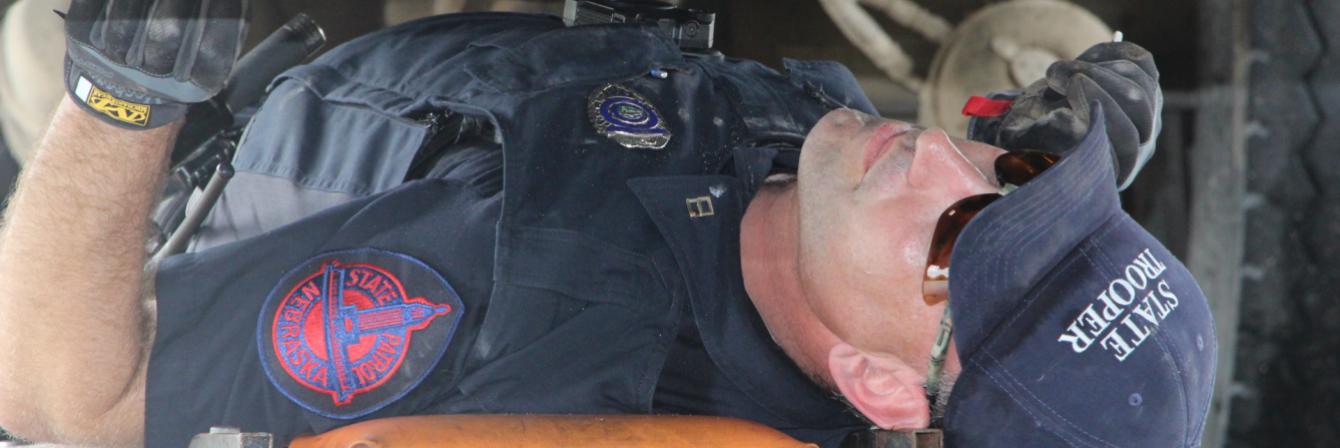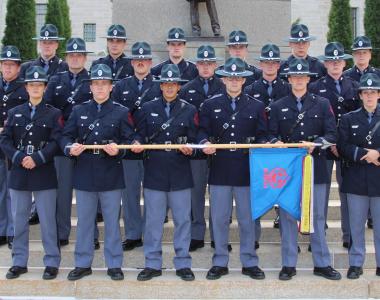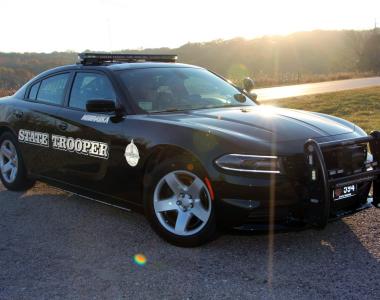The Federal Hazardous Materials Regulations (HMR) apply to persons who transport hazardous materials or cause hazardous materials to be transported in interstate or intrastate commerce.
Nebraska adopted the following parts of the Federal Hazardous Materials Regulations:
The parts, subparts, and sections of Title 49 of the Code of Federal Regulations listed below, or any other parts, subparts, and sections referred to by such parts, subparts, and sections, are adopted as part of Nebraska law and, shall be applicable to all motor carriers whether engaged in interstate or intrastate commerce, drivers of such motor carriers, and vehicles of such motor carriers:
(1) Part 107- Hazardous Materials Program Procedures, subpart F-Registration of Cargo Tank and Cargo Tank Motor Vehicle Manufacturers, Assemblers, Repairers, Inspectors, Testers, and Design Certifying Engineers.
(2) Part 107- Hazard Materials Program Procedures, subpart G-Registration of Persons Who Offer or Transport Hazardous Materials;
(3) Part 171- General Information, Regulations, and Definitions;
(4) Part 172- Hazardous Materials Table, Special Provisions, Hazardous materials Communications, Emergency Response Information, and Training Requirements and Security Plans;
(5) Part 173- Shippers-General Requirements for Shipments and Packaging's;
(6) Part 177- Carriage By Public Highway;
(7) Part 178- Specifications For Packaging's; and
(8) Part 180- Continuing Qualification and Maintenance of Packaging's.
Agricultural operations exceptions for Intrastate Commerce
(a) For other than a Class 2 material, the transportation of an agricultural product over local roads, between fields of the same farm, is excepted from the requirements of this subchapter. A Class 2 material transported over local roads between field of the same farm is excepted from subparts G and H of part 172 of this subchapter. In either instance, transportation of the hazardous material is subject to the following conditions;
(1) It is transported by a farmer who is an intrastate private motor carrier; and
(2) The movement of the agricultural product conforms requirements of the State in which it is transported and is specifically authorized by a State statute or regulation in effect before October 1, 1998.
(b) The transportation of an agricultural product to or from a farm, within 150 miles of the farm, is excepted from the requirements and from the specific packaging requirements when:
(1) It is transported by a farmer who is an intrastate private motor carrier;
(2) The total amount of agricultural product being transported on a single motor vehicle does not exceed:
-7,300 kg (16,096 lbs.) of ammonium nitrate fertilizer properly classed as Division 5.1, PG III, in a bulk packaging; or
- 1900 L (502 gallons) for liquids or gases, or 2,300 kg (5,070 lbs.) for solids, of any other agricultural product;
(3) The movement and packaging of the agricultural product conform to the requirements of the state in which it is transported, and specifically authorized by State statute or regulation in effect before October 1, 1998; and
(4) Each person having any responsibility for transporting the agricultural product or preparing the agricultural product for shipment has been instructed in the applicable requirements of this subchapter.
(c) Formulated liquid agricultural products in specification packaging's of 220L (58 gallons) capacity or less, with closures manifold to a closed mixing system and equipped with positive dry disconnect devices may be transported by a private motor carrier between a final distribution point and an ultimate point of application or for loading aboard an airplane for aerial application.
(d) Moveable fuel storage tenders. A non-DOT specification cargo tank motor vehicle may be used to transport Liquefied petroleum gas, UN1075, including Propane, UN1978, as moveable fuel storage tender used exclusively for agricultural purposes when operated by a private carrier under the following conditions;
(1) The cargo tank must have a minimum design pressure of
250 psig.
(2) The cargo tank must meet the requirements of the HMR
in effect at the time of its manufacture and must be
marked accordingly. For questions regarding these
requirements, contact PHMSA by either:
(i) Telephone (800) 467-4922 or (202) 366-4488 (local)
(ii) By electronic mail (e-mail) to: infocntr@dot.gov
(3) The cargo tank must have a water capacity of 1,200
gallons or less.
(4) The cargo tank must conform to applicable requirements
in National Fire Protection Association (NFPA) 58,
Liquefied Petroleum Gas Code (lBR, see §171.7 of this
subchapter.
(5) The cargo tank must be securely mounted on a motor
vehicle.
(6) The cargo tank must be filled in accordance with
§ 173.315(b) for liquefied petroleum gas.
(7) The cargo tank must be painted white, aluminum, or other
light-reflecting color.
(8) Transportation of the filled moveable fuel storage tender
is limited to movement over local roads between fields
using the shortest practical distance.
(9) Transportation of the moveable fuel storage tender
between its point of use and a liquefied petroleum gas
distribution facility is authorized only if the cargo tank
contains no more than five percent of its water capacity. A
movable fuel storage tender may only be filled at the
consumer's premises or point of use.
(e) Liquid soil pesticide fumigants. MC 306 and DOT 406 cargo tank motor vehicles and DOT 57 portable tanks may be used to transport liquid soil pesticide fumigants, Pesticides, liquid toxic, flammable, n.o.s., flash point not less than 23 degrees C, 6.1, UN2903, PG II, exclusively for agricultural operations by a private motor carrier between a bulk loading facility and a farm (including between farms). However, transportation is not to exceed 150 miles between the loading facility and the farm, and not more than five days are permitted for intermediate stops for temporary storage. Additionally, transport is permitted only under the following conditions:
(1) Cargo tanks. MC 306 and DOT 406 cargo tank motor
vehicles must:
(i) Meet qualification and maintenance requirements (including
Periodic testing and inspection) in accordance with Subpart
E of Part 180 of this subchapter;
(ii) Conform to the pressure relief system requirements
Specified in §173.243(b)(1);
(iii) For MC 306 cargo tanks, be equipped with stop-valves
capable of being remotely closed by manual and
mechanical means; and
(iv) For DOT 406 cargo tanks, conform to the bottom outlet
requirements specified in §173.243(b)(2);
(2) Portable tanks. DOT 57 portable tanks must:
(i) Be constructed of stainless steel; and
(ii) Meet qualification and maintenance requirements of
Subpart G of Part 180 of this subchapter.
(f) See §173.315(m) pertaining to nurse tanks of anhydrous ammonia.
(g) See §173..6 pertaining to materials of trade.
(h) See §172.800(b) pertaining to security plans.
Exceptions for nonspecification packaging used in intrastate transportation
(a) Non-specification bulk packaging's. Notwithstanding requirements
for specification packaging's in subpart F, of this part and parts 178
and 180, of this subchapter, a non-specification bulk packaging may be
used for transportation of a hazardous material by an intrastate motor
carrier until July 1, 2000, in accordance with the provisions of paragraph
(d) of this section.
(b) Non specification cargo tanks for petroleum products:
Notwithstanding requirements for specification packaging in subpart F of this part, and parts 178 and 180 of this subchapter, a non- specification cargo tank motor vehicle having a capacity of less than 13,250 L (3,500 gallons,) may be used by an intrastate motor carrier for transportation of a flammable liquid petroleum product in accordance with the provisions of paragraph (d) of this section:
(c) Permanently secured non-bulk tanks for petroleum products:
Notwithstanding requirements for specification packaging's in subpart F, of this part 173, and parts 178 and 180 of this subchapter, a non- specification metal tank permanently secured to a transport vehicle and protected against leakage or damage in the event of a turnover, having a capacity of less than 450 L (119 gallons,) may be used by an intrastate motor carrier for transportation of a flammable liquid petroleum product in accordance with the provisions of paragraph (d) of this section.
(d) Additional requirements: A packaging used under the provisions of paragraphs (a), (b) or (c) of this section must:
(1) Be operated by an intrastate motor carrier and in use as a packaging for hazardous material before October 1, 1998;
(2) Be operated in conformance with the requirements of the State in which it is authorized;
(3) Be specifically authorized by State statute or regulation, in effect before October 1, 1998, for use as a packaging for the hazardous material being transported.
(4) Be offered for transportation and transported in conformance with all other applicable requirements.
(5) Not be used to transport a flammable cryogenic liquid, hazardous substance, hazardous waste, or a marine pollutant;(except for gasoline) and
(6) For a tank authorized under paragraph (b) or (c) of this section, conform to all requirements in part 180, except for §180.405(g)) of this subchapter in the same manner as required for a specification MC306 cargo tank motor vehicle.
Definitions
Agricultural product, means a hazardous material, other than a hazardous waste, whose end use directly supports the production of an agricultural commodity, including, but not limited to, a fertilizer, pesticide, soil amendment, or fuel. An agricultural product, is limited to a material in Class 3, 8 or 9. Division 2.1, 2.2, 5.1, 6.1 or an ORM-D material.
Bulk packaging means a packaging, other than a vessel or a barge, including a transport vehicle or freight container, in which hazardous materials are loaded with no intermediate form of containment. A large packaging in which hazardous materials are loaded with an intermediate form or containment, such as one or more articles or inner packaging's, is also a bulk packaging. Additionally, a bulk packaging has;
(1) A maximum capacity greater 450 L (119 gallons) as a receptacle for a liquid;
(2) A maximum net mass greater than 400kg (882 pounds) and a maximum capacity greater than 450 L (119 gallons) as a receptacle for a solid; or
(3) A water capacity greater than 454kg (1000 pounds) as a receptacle for a gas as defined in this subchapter.
Farmer means a person engaged in the production or raising of crops, poultry, or livestock.
Interstate commerce, means trade, traffic, or transportation provided in the furtherance of a commercial enterprise in the United States.
(a) Between a place in a state and a place outside of such state, including a
place outside of the United States;
(b) Between two places in a state through another state, or outside of the
United States; or
(c) Between two places in a state as part of trade, traffic, or transportation
originator terminating outside the state or the United States;
Intrastate Commerce means any trade, traffic, or transportation provided in the furtherance of a commercial enterprise between any place in the State of Nebraska and any other place in Nebraska and not through any other state.
For additional definitions see Nebraska Revised Statutes 75-362 and Title 49 of the Code of Federal Regulation §171.8
Hazardous Materials Safety Permit
If you are a motor carrier and will be carrying any of the following hazardous materials, you will be required to apply for a Hazardous Materials Safety Permit on Form MCS-150B (Combined Motor Carrier Identification Report and HM Permit Application). In addition you will be required to apply for a Hazardous Materials Registration prior to being issued a USDOT number for intrastate or interstate commerce.
After the date following January 1, 2005, that a motor carrier is required to file a Motor Carrier Identification Report Form (MCS-150) according to the schedule set forth in §390.19(a) of this chapter, the motor carrier may not transport in interstate or intrastate commerce any of the following hazardous materials, in the quantity indicated for each, unless the motor carrier holds a safety permit:
(a) A highway route-controlled quantity of a Class 7 (radioactive) material, as defined in §173.403 of this title;
(b) More than 25 kg (55 pounds) of a Division 1.1, 1.2, or 1.3 (explosive) material or an amount of a Division 1.5 (explosive) material requiring placarding under part 172 of this title;
(c) More than one liter (1.08 quarts) per package of a "material poisonous by inhalation," as defined in §171.8 of this title, that meets the criteria for "hazard zone A," as specified in §173.116(a) or §173.133(a) of this title;
(d) A "material poisonous by inhalation," as defined in §171.8 of this title, that meets the criteria for "hazard zone B," as specified in §173.116(a) or §173.133(a) of this title in a bulk packaging, capacity greater than 450 L (119 gallons);
(e) A "material poisonous by inhalation," as defined in §171.8 of this title, that meets the criteria for "hazard zone C," or "hazard zone D," as specified in §173.116(a) of this title, in a packaging having a capacity equal to or greater than 13,248 L (3,500) gallons; or
NOTE: Paragraph (e) includes Anhydrous Ammonia since it is a "material poisonous by inhalation" in Hazard Zone D. The Hazardous Materials safety permit would apply to cargo tank transports hauling Anhydrous Ammonia however; a Hazardous Materials Safety Permit would not be required for nurse tanks hauling Anhydrous Ammonia since they are 3000 gallons or less by definition.
(f) A shipment of compressed or refrigerated liquefied methane or liquefied natural gas, or other liquefied gas with a methane content of at least 85 percent, in a bulk packaging having a capacity equal to or greater than 13,248 L (3,500 gallons).
The compliance date for all motor carriers hauling any of the above mentioned hazardous materials in the quantities described above, to have the Hazardous Materials Safety Permit is January 1, 2007.
The Hazardous Materials Safety Permit can be obtained from the Federal Motor Carrier Safety Administration (FMCSA) by applying online at www.fmcsa.dot.gov.
Hazmat Registration Requirements
The registration and fee requirements of this subpart apply to any person who offers for transportation, or transports, in foreign, interstate or intrastate commerce;
(1) A highway route-controlled quantity of a Class 7 (radioactive) material, as defined in §173.403 of this chapter;
(2) More than 25 kilograms (55 pounds) of a Division 1.1, 1.2, or 1.3 (explosive) material (a see §173.50 of this chapter) in a motor vehicle, rail car, or freight container;
(3) More than one L (1.06 quarts) per package of a "material extremely toxic by inhalation" (i.e.., "material poisonous by inhalation" as defined in § 171.8 of this chapter, that meets the criteria for "hazard zone A'. as specified in §173.116(a) of this chapter);
(4) A shipment of a quantity of hazardous materials in bulk packaging (see §171.8 of this chapter) having a capacity equal or greater than 13,248 L (3,500 gallons) for liquids or gases or more than 13.24 cubic meters (468 cubic feet) for solids.
(5) A shipment in other than a bulk packaging of 2,268 kg (5,000 pounds) gross weight or more of one class of hazardous materials (including hazardous wastes) for which placarding of a vehicle, rail car, or freight container is required for that class, under the provisions of subpart For part 172 of this chapter; or
(6) Except as provided in paragraph (b) of this section, a quantity of hazardous material that requires placarding, under provisions of subpart F of part 172 of this chapter; or
(b) Paragraph (a)(6) of this section does not apply to those activities of a farmer, as defined in § 171.8 of this chapter, that are in direct support of the farmer's farming operation.
(c) In this subpart, the term "shipment" means the offering or loading of hazardous material at one loading facility using one transport vehicle, or the transport of that transport vehicle.
Hazmat Registration Payment Procedures
(a) Each person subject to the requirements of this subpart must mail the registration statement and payment in full to the U.S... Department of Transportation, Hazardous Materials Registration, P.O.. Box 530273, Atlanta, GA 30353-0273, or submit the statement and payment electronically through the Department's e-Commerce Internet site. Access to this service is provided at < http://phmsa.dot.gov/hazmat/registration > A registrant required to file an amended registration statement under §107.608(c) must mail it to the same address or submit it through the same Internet site.
(b) Payment must be made by certified check, cashier's check, personal check, or money order in U.S... funds and drawn on a U.S... bank, payable to the U.S... Department of Transportation and identified as payment for the "Hazmat Registration Fee," or by completing an authorization for payment by credit card or other electronic means of payment acceptable to the Department on the registration statement or as part of an internet registration as provided in paragraph (a) of this section.
(c) Payment must correspond to the total fees properly calculated in the "Amount Due" block of the DOT form F 5800.2. A person may elect to register and pay the required fees for up to three registration years by filing one complete and accurate registration statement.
Frequently asked questions:
1) Does Nebraska require a state hazardous material or hazardous waste permit in addition to what is required by the U.S.. D.O.T.?
Answer: No
2) The hazardous materials regulations require hazmat employers train their hazmat employees within 90 days of employment and once every three years thereafter. Does the State Patrol provide training to shippers and carriers that would comply with the regulations?
Answer: No
3) Do I have to test my non-specification cargo tank if I transport gasoline or gasohol?
Answer: If you have a non-specification cargo tank with a capacity less than 3,500 gallons used for the transportation of petroleum products in intrastate commerce, then the cargo tank must be periodically tested by the MC 306 cargo tank testing standards. If the cargo tank is used to transport diesel fuel or fuel oil only, then the cargo tank is not required to be tested.
4) Do I have to carry shipping papers when transporting nurse tanks of Anhydrous Ammonia?
Answer: No. The regulations do not require shipping papers.
5) Am I required to have a shipping paper for a cargo tank less than 3,500 gallons used to transport petroleum products (gasoline, gasohol, or diesel fuel) when "empty"?
Answer: Yes. The regulations require carriers to have proper shipping papers whether the cargo tank is "empty" or loaded. The only time a shipping paper would not be required, is when the tank is cleaned and purged, or loaded with a non-hazardous material.
6) Who can I contact for more information on the Hazardous Materials Regulations?
Answer:
Nebraska State Patrol
Lincoln(402) 471-0105
United States Department of Transportation
Federal Motor Carrier Safety Administration (FMCSA) in Lincoln (402) 437-5986
Pipeline and Hazardous Materials Safety Administration (PHMSA) in Washington D.C..(800) 467-4922
U.S.. Department of Transportation (PHMSA)






